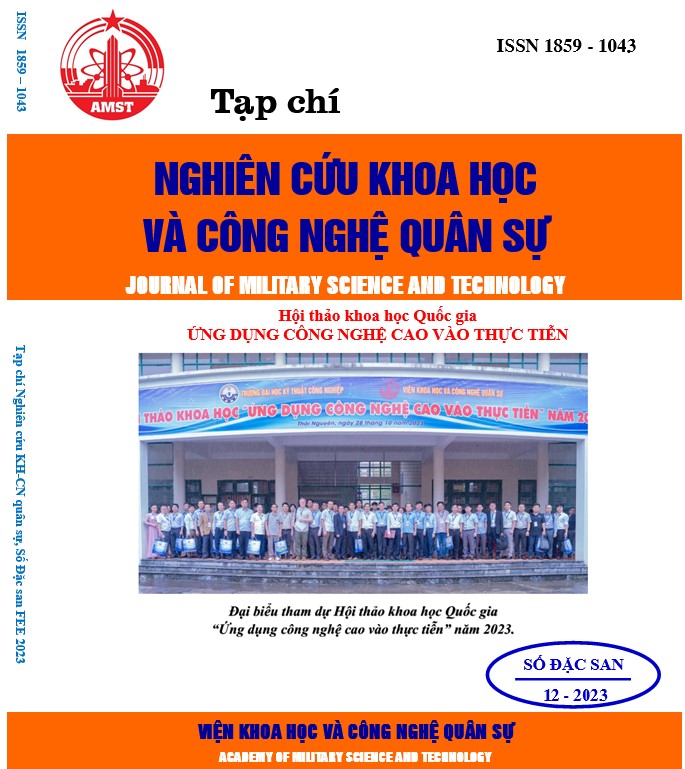Research on the stability of concentration and biological activity of preparation including Bacillus subtilis, quercetin under experimental conditions
384 viewsDOI:
https://doi.org/10.54939/1859-1043.j.mst.FEE.2023.264-270Keywords:
Bacillus subtilis; DPPH; Quercetin.Abstract
The efficiency of a biological preparation depends on many factors, especially the density of its bacteria. During shelf life, protective conditions do not have any factor that reduces the number of spore bacteria. This study determined the stability of quercetin content (mg), density of Bacillus subtilis (CFU/g) and DPPH antioxidant activity (%), antibacterial activity, etc., in storage time. The obtained results showed that after storage time at room temperature of 30 °C, the quercetin content in the preparation was maintained at 44,74 ± 0,15 mg/g, the density of Bacillus subtilis was about 5,32 x 106 CFU/g. The product, during storage, showed antioxidant activity with the ability to neutralize DPPH > 60% and was active against tested bacteria E. coli, Salmonella at experimental conditions.
References
[1]. Aguirre JS., Pin C., Rodriguez MR., García de Fernando GD. “Analysis of the Variability in the Number of Viable Bacteria after Mild Heat Treatment of Food”, Appl. Environ. Microbiol, 75, 6992-6997, (2009). DOI: https://doi.org/10.1128/AEM.00452-09
[2]. Đề tài cấp Viện Công nghệ mới năm 2021 “Nghiên cứu tạo chế phẩm Synbiotic-Plus (chứa chất xơ, men vi sinh, flavonoid) và đánh giá hoạt tính chống oxy hóa trên động vật thực nghiệm”.
[3]. Mohapatra D. P., V. Thakur., S. K. Brar, "Antibacterial efficacy of raw and processed honey", Biotechnol Res Int, p. 917505, (2011). DOI: https://doi.org/10.4061/2011/917505
[4]. Mputu Kanyinda., Jean-noel & Jacqueline., Destain & Philippe., Noki & Philippe., Thonart, “Accelerated storage testing of freeze-dried Pseudomonas fluorescens BTP1, BB2 and PI9 strains”, African journal of biotechnology, 11, 16187-16191, (2012). DOI: https://doi.org/10.5897/AJB12.2370
[5]. Jaisinghani., R. N. “Antibacterial properties of quercetin”, Microbiology Research, 8, 1, (2017). https://doi.org/10.4081/mr.2017.6877. DOI: https://doi.org/10.4081/mr.2017.6877
[6]. Nguyễn Lân Dũng., Nguyễn Đình Quyến., Phạm Văn Ty, “Một số phương pháp nghiên cứu vi sinh vật”, NXB Khoa học và kĩ thuật, Hà Nội, 27-35, (1989).
[7]. Nguyễn Thị Kim Liên, Chế Quang Minh, Nguyễn Hương Thư, “Định lượng flavonoid toàn phần trong cao khô Rau đắng đất (Glinus oppositifolius (L.) Aug. DC.) bằng phương pháp quang phổ UV-VIS”, Tạp chí Khoa học & Công nghệ số 5, p 57-61, (2018). DOI: https://doi.org/10.55401/jst.v2i1.152
[8]. Plank D. W., Szpylka J., Sapirstein H., Woollard D., Lee V., Chen, C. Y. O.; Liu R. H., Tsao R., Düsterloh A., Baugh S, “Determination of Antioxidant Activity in Foods and Beverages by Reaction with 2,2′-Diphenyl-1-Picrylhydrazyl (DPPH)”, J. AOAC Intern. 95, 1562-1569, (2012). DOI: https://doi.org/10.5740/jaoacint.CS2012_04
[9]. https://dav.gov.vn/images/upload_file/2022/iii15-huong-dan-nghien-cuu-do_on_dinh_cua_thuoc_2- phu-luc-i-kem-tt_1646996218.pdf.
[10]. http://www.fda.gov/food/generally -recognized-safe-gras/gras-notice-inventory.







